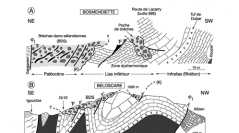

 Comptes Rendus Palevol
5 (7) - Pages 859-866
Comptes Rendus Palevol
5 (7) - Pages 859-866Palaeocene marine breccias, the so-called ‘Etchebar/Bosmendiette breccias’, from the area of Tardets (Zone des Chaînons Béarnais, Pyrenées-Atlantiques, France) are interpreted as gravitational deposits (debris-flow) overlying a folded Jurassic and Early Cretaceous carbonate substrate and overlain, in turn, by the karstified rims of palaeocanyons, which, on the axis of the future range, were excavated during the “Laramide” orogenic phase at the end of the Cretaceous and the beginning of the Palaeocene. We clarify the cartographic, sedimentologic and petrographic characteristics of these breccias in this paper. Early/Middle Palaeocene (Late Danian–Early Selandian, P1c-P3 zonal interval) pelagic assemblages of ‘Globigerinacea’ are identified from new thin-section samples in their argillaceous carbonate matrix as well as within interbedded hemipelagites. These breccias are now well known and well dated along the Pyrenees from the ‘Corbières’ (to the east) to the Marble Thrust Sheet (to the west). The hypothesis of their diapiric origin founded on their supposed Aptian age must be consequently definitely rejected.
Foraminifères, Brèches, Paléocène, Pyrénées-Atlantiques, France